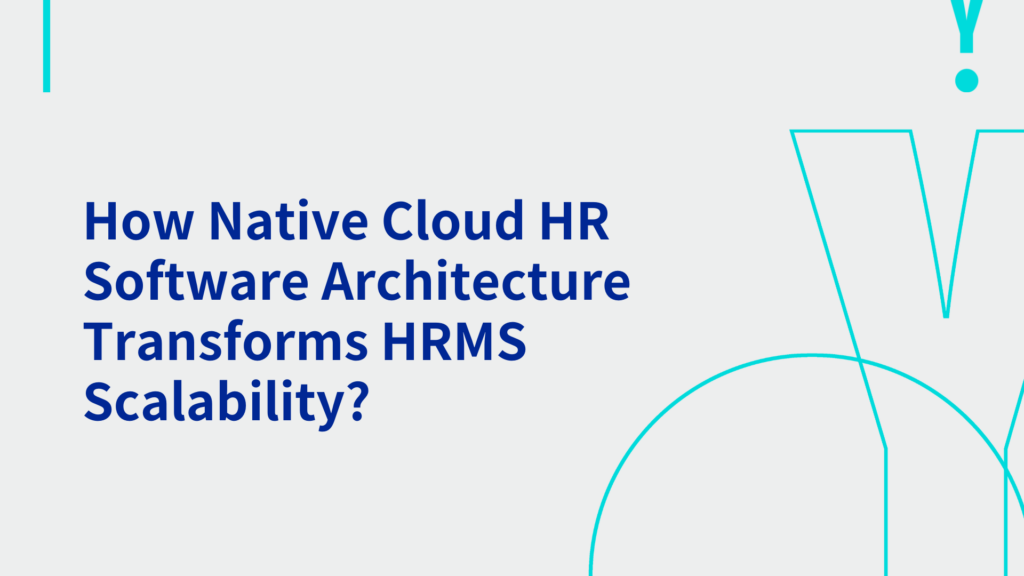
Big global businesses thrive on agility and growth. Yet, outdated HR systems often stall expansion, hinder workflows, and frustrate teams worldwide. Traditional on-premises HRMS platforms buckle under massive data, diverse compliance needs, and multi-location demands.
With a globally dispersed workforce, you need a cloud HR software that scales effortlessly without hefty downtime or performance dips. That’s where cloud-native architecture steps in, transforming rigid HRMS into dynamic, scalable solutions. Therefore, by harnessing microservices, containerization, and robust APIs, cloud-native HRMS ensures your HR processes evolve with business needs. Moreover, you gain real-time data access, seamless integrations, and flexible modules. But what does that mean for your HR team’s productivity and your global strategy?
In this blog, we’ll unpack how cloud-native design elevates HRMS scalability, supports future growth, and reduces IT headaches. So, stay with us—discover why cloud-native isn’t just a tech trend but a powerful HR revolution your global enterprise cannot ignore.
- The Scalability Challenge: Why Legacy HRMS Falls Short?
- What Makes An HRMS Cloud-Native?
- Microservices: The Backbone of Cloud Scalability
- Containerization for Consistency Across Environments
- API-First Design: Seamless Cloud HR Software Integrations Made Easy
- Global Compliance Made Simpler
- Cost Optimization: Pay As You Grow
- Empowering HR Teams: Focus on People, Not Tech
- Is Cloud-Native HRMS Right for Your Business?
- End Note
The Scalability Challenge: Why Legacy HRMS Falls Short?
Let’s start with the obvious—legacy HRMS platforms weren’t designed for today’s business velocity.
- On-premises systems demand heavy hardware investments. Scaling them means adding servers, upgrading infrastructure, and dealing with maintenance downtime.
- Consequently, your HR team faces bottlenecks during peak hiring or onboarding phases. Moreover, global expansion introduces diverse tax rules, languages, and compliance laws. With legacy systems, adapting workflows for each region requires custom coding or expensive add-ons. That’s not just inefficient; it slows decision-making.
- In contrast, cloud-native HRMS leverages distributed computing power. So, when your business adds locations or thousands of new employees, the system auto-scales resources. No hardware upgrades, no performance hiccups—just continuous service availability.
Therefore, switching to cloud-native architecture addresses the fundamental scalability gap that legacy HRMS cannot bridge. It could also be helpful for expense claim management requirements.
What Makes An HRMS Cloud-Native?
So, what exactly defines a cloud-native HRMS?
Unlike traditional systems that were simply migrated to the cloud, a true cloud-native HRMS is built for cloud environments from day one. It uses a microservices architecture, breaking down complex processes into independent, manageable components.
Each module, like payroll or leave management, operates separately but communicates via robust APIs. This modular design means updates roll out faster, with minimal disruption. Moreover, containerization ensures your HRMS runs consistently across different environments.
Think of containers like lightweight, portable packages—they hold everything an application needs to run smoothly. If you want to test a new HR feature for your Asia Pacific team, you can deploy it in a container without impacting the entire system. Therefore, you get flexibility and agility to adapt HR processes regionally.
Microservices: The Backbone of Cloud Scalability
Microservices are the unpopular things behind HRMS scalability. Here’s why they matter so much.
In monolithic systems, if one part fails—say, the payroll module crashes—it can bring down the entire HRMS. That’s an IT nightmare no global business wants. With microservices, each module operates independently. So, a glitch in one service won’t cripple the whole system. Plus, you can scale individual services based on demand with well-designed cloud HR software.
For instance, during year-end appraisals, the performance management module may need more computing resources. With cloud-native architecture, you simply allocate more to that microservice—no need to over-provision the entire system.
This granular scalability optimizes costs and performance. Moreover, microservices facilitate continuous development and deployment. Your HR tech team can push updates or new features faster, thus keeping the system fresh and competitive.
Containerization for Consistency Across Environments
Now, let’s talk about containerization—another game-changer for big businesses. Containers bundle software code with its dependencies, ensuring it runs the same way everywhere. So, whether your HRMS operates in your data center, public cloud, or hybrid cloud, containers guarantee consistency.
Imagine expanding your operations into new countries. You need to deploy HR modules quickly while complying with local regulations. Containers make it possible to replicate and customize modules without delay.
Furthermore, container orchestration tools like Kubernetes help automate scaling. They monitor workloads and adjust resources in real time.
So, during high-volume activities—like onboarding thousands of seasonal workers—your HRMS auto-scales without manual intervention. As a result, you achieve reliable performance and availability for your global workforce.
API-First Design: Seamless Cloud HR Software Integrations Made Easy
Big enterprises rarely use standalone HRMS. You probably integrate payroll, ERP, recruitment, expenses claim management, and third-party apps. Here’s where an API-first approach stands out. A cloud-native HRMS built with robust APIs connects easily with other business systems. Need to sync data between HRMS and your global finance software?
With APIs, the integration is smoother and faster. Moreover, APIs ensure data flows securely and accurately. So, your HR and finance teams always work with real-time information. This reduces errors, eliminates duplicate entries, also boosts decision-making.
As your company grows, you will need new tools and platforms. A flexible API ecosystem means you can plug and play without costly re-engineering. In other words, your HRMS stays future-ready, supporting digital transformation goals.
Global Compliance Made Simpler
- Compliance is a headache for any global business. Different regions have unique tax rules, labor laws, and data privacy standards. A cloud-native HRMS simplifies compliance management with modular, region-specific features.
- You can deploy local payroll engines, adapt leave policies, or generate statutory reports for each country. Since everything operates in the cloud, updates roll out automatically when regulations change. Your HR team stays compliant without scrambling for manual fixes.
- Plus, robust data encryption and multi-factor authentication keep sensitive employee information safe. This level of compliance readiness protects your business from penalties and reputational damage.
Cost Optimization: Pay As You Grow
Here’s another perk of integrating the best cloud HR software: cost savings. On-premises HRMS ties you down with fixed infrastructure costs, whether you use the capacity or not. In contrast, cloud-native architecture follows a pay-as-you-go model.
You expand resources up or down in response to demand. For example, during seasonal hiring surges, your HRMS expands automatically. Once the hiring cycle ends, it scales back to reduce costs. So, you avoid over-provisioning and pay only for what you use.
Hence, this flexibility helps global businesses manage HR technology budgets efficiently, freeing up funds for innovation.
Empowering HR Teams: Focus on People, Not Tech
Finally, cloud-native HRMS transforms the HR team’s role. They spend less time troubleshooting tech issues or waiting for IT support. With intuitive self-service portals, employees manage their profiles, benefits, and leave requests easily.
Meanwhile, HR teams focus on strategic initiatives, like improving employee experience, driving engagement, or designing talent development programs. When HR feels empowered, the entire organization thrives.
Is Cloud-Native HRMS Right for Your Business?
By now, you can see the clear advantages. Cloud-native architecture transforms HRMS into a scalable, agile, and resilient system that grows with your business. It boosts efficiency, simplifies compliance, and empowers HR teams to drive people-centric strategies.
So, if you are planning global expansion, investing in a cloud-native HRMS isn’t optional—it’s a smart move. Ready to future-proof your HR operations?
Explore cloud-native solutions tailored to your enterprise’s unique needs today.
End Note
Scalability shouldn’t hold your growth back. With cloud-native architecture, your HRMS becomes an enabler, not a bottleneck. The best cloud HR software empowers your workforce, optimizes costs, and keeps your business compliant worldwide.
Now is the time to shift gears and adopt a solution built for the future. So, connect with YOOV, assess your current systems, and embrace the agility only cloud-native HRMS can offer. Your global teams—and bottom line—will work with greater efficiency.
Connect with YOOV

WhatsApp:Click Here
Email:hello@yoov.com
Website:https://www.yoov.com/